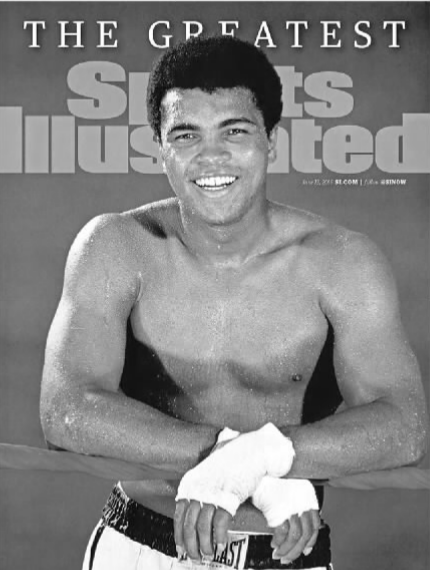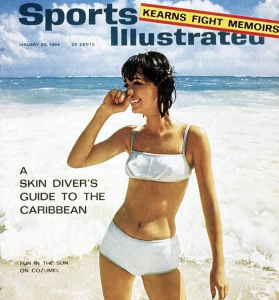Featured Articles
Boxing in the Pages of Sports illustrated: A Short History

Boxing in the Pages of Sports illustrated: A Short History
Last week, Sports Illustrated laid off virtually its entire staff. This would seem to presage the end of the print edition, and, if so, it comes as no great surprise. It had become apparent that the storied publication was hanging on by a thread.
Sports Illustrated (henceforth S.I.) debuted with the issue dated Aug. 16, 1954. Eddie Matthews, the slugging third baseman of the Milwaukee Braves, was on the cover. The following year, in September, Rocky Marciano had the distinction of being the first prizefighter to appear on the cover. A few days after the issue hit the newsstands, Marciano defended his heavyweight title with a ninth-round stoppage of Archie Moore in what would prove to be Rocky’s farewell fight.
Boxing was big in those days, as evident by the fact that Marciano’s successor, Floyd Patterson, made four appearances on the S.I. cover. Moreover, it speaks reams that two of Patterson’s would-be conqueror’s, Tom McNeeley and Roy “Cut and Shoot” Harris, were also the subjects of an S.I. cover story. Neither had a snowball’s chance against Patterson, but putting their faces on the cover of S.I. legitimated them in the eyes of casual fans.
Ingemar Johansson, a one-trick pony of sorts, was featured on the cover after upsetting Patterson in 1959 in the first of their three meetings. More than that, S.I. named him the Sportsman of the Year.
There was a back story. S.I. had been running a series of stories detailing mob involvement and corruption in the sweet science and was pushing for the establishment of an international body to regulate the sport. What better person to lead the charge than the reigning heavyweight champion?
“The purpose of this organization must be to restore public confidence in boxing, which has been badly hurt by scandals and to protect the fighters, who have been too often manipulated by powerful promoters and unscrupulous managers,” Ingemar was quoted as saying.
In the ensuing six-plus decades, only two other boxers, Muhammad Ali (1974) and Sugar Ray Leonard (1981), would be named the S.I. Sportsman of the Year.
Ali made his first appearance on the S.I. cover as Cassius Clay in 1963. He and basketball star Michael Jordan would wage a battle for the most S.I. covers, distancing the field like Secretariat in the 1973 Belmont Stakes, with Jordan eventually inching ahead.
Ali appeared with Joe Frazier on the cover on the 25th anniversary of their first conflagration, the Fight of the Century. He made his 39th appearance on Sept. 1, 2015, when S.I. re-named its Legacy Award the Muhammad Ali Legacy Award and appeared again the following year in a special souvenir edition following his death.
Ali’s first cover (June 10, 1963) and Mike Tyson’s first cover (Jan. 6, 1986) are two of the most prized by collectors. Newsstand copies (no mailing label) in pristine condition have fetched low five-figure sums at auctions.
Tyson, then sporting the nickname Kid Dynamite, was only 19 years old and had been a pro for only nine months when he made his S.I. debut. In terms of public recognition, no boxer was ever such a comet coming out of the amateur ranks.
—
Although S.I. doubled its circulation and tripled its advertising revenue within five years of its inception, it reportedly did not become profitable until 1964. When it turned the corner, however, it was full speed ahead. By 1970, S.I. ranked fourth in circulation among weekly publications, trailing only TV Guide, Time, and Newsweek. By the end of the century, base circulation topped three million. It would be written that S.I. was read by 19 percent of the adult males in the United States.
On Jan. 20, 1984, a swimsuit model, one Babette March, graced the cover. This would be considered the birth of the S.I. swimsuit era, an annual tradition that evolved into a franchise, spawning calendars, DVDs, pageants, and whatnot.

The sport that got the biggest play in this issue was boxing as it featured the second installment of Jack “Doc” Kearns’ memoir, an 8-page excerpt from his forthcoming autobiography (written with Oscar Fraley).
The previous week, S.I. had caused a furor by publishing Kearns’ “confession” that he had loaded Jack Dempsey’s gloves with plaster of Paris before his match with Jess Willard. (Dempsey sued for libel. His attorney won an out-of-court settlement. The legal proceedings delayed the publication of the memoir and when the book was finally released, the offending portion was deleted. By then the wily Kearns, a central character in the Golden Era of Sports, was long dead.)
Christie Martin appeared on the cover of S.I. in 1996 in the April 15 edition, a watershed moment in the history of female boxing. As for the oddest boxer to make the cover, the honor goes to Gypsy Joe Harris, a colorful character from the mean streets of North Philadelphia whose career was cut short when it was discovered that he was blind in one eye. Although Harris owned a win over welterweight title-holder Curtis Cokes in a non-title fight, he wasn’t even ranked when his face appeared on the S.I. cover in June of 1967.
The Gypsy Joe story was by Mark Kram and one surmises it made the cover simply because Kram’s writing was too good to let the story be buried in the table of contents. Over the years, S.I. employed some of the best boxing writers on the planet including none other than the great Budd Schulberg who edited the publication’s early boxing pieces. The list of outstanding wordsmiths is long with special citations going to Kram and to Pat Putnam, the longest tenured of the boxing writers.
“Watching the magazine deteriorate,” wrote Matthew Rees, “has had the feel of witnessing the decline of a once-iconic athlete.”
As the swimsuits became skimpier, so did the magazine as a whole, gutted by the loss of advertising revenue. True, no one bought the magazine for the ads, but they made the magazine heftier which made the price of it seem like a squarer deal. What happened at S.I. happened at other mass circulation news magazines, dinosaurs in a digital age when we can summon up a wealth of information on the smartphone we carry in the pocket of our pants. Perhaps a third of S.I.’s readers got their copy at a newsstand, perhaps an impulsive purchase dictated by who happened to be on the cover and nowadays, in many communities, the only good newsstands are found at an airport and even they are inferior to the better newsstands of yesteryear that catered to a larger demographic by offering a wider range of publications.
In its glory days and beyond, Sports Illustrated was the gold standard of sports journalism. We miss those days. Thanks for the memories.
—
Arne K. Lang is a recognized authority on the history of prizefighting and the history of American sports gambling. His latest book, titled Clash of the Little Giants: George Dixon, Terry McGovern, and the Culture of Boxing in America, 1890-1910, was released by McFarland in September, 2022.
To comment on this story in the Fight Forum CLICK HERE
-

 Featured Articles3 weeks ago
Featured Articles3 weeks agoThe Hauser Report: Zayas-Garcia, Pacquiao, Usyk, and the NYSAC
-

 Featured Articles2 weeks ago
Featured Articles2 weeks agoOscar Duarte and Regis Prograis Prevail on an Action-Packed Fight Card in Chicago
-

 Featured Articles1 week ago
Featured Articles1 week agoThe Hauser Report: Cinematic and Literary Notes
-

 Book Review5 days ago
Book Review5 days agoMark Kriegel’s New Book About Mike Tyson is a Must-Read
-

 Featured Articles4 weeks ago
Featured Articles4 weeks agoManny Pacquiao and Mario Barrios Fight to a Draw; Fundora stops Tim Tszyu
-

 Featured Articles4 weeks ago
Featured Articles4 weeks agoArne’s Almanac: Pacquiao-Barrios Redux
-

 Featured Articles3 weeks ago
Featured Articles3 weeks agoRemembering Dwight Muhammad Qawi (1953-2025) and his Triumphant Return to Prison
-

 Featured Articles4 weeks ago
Featured Articles4 weeks agoOleksandr Usyk Continues to Amaze; KOs Daniel Dubois in 5 One-Sided Rounds


















